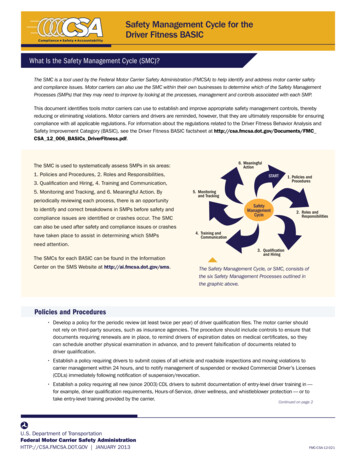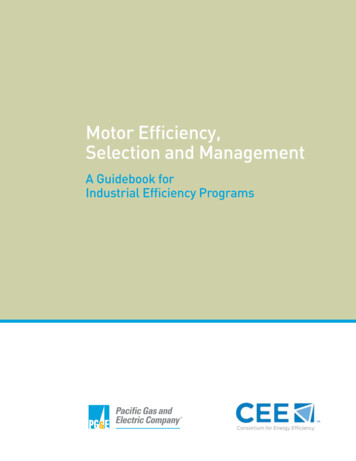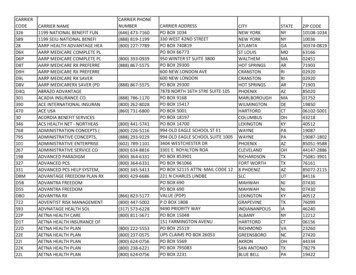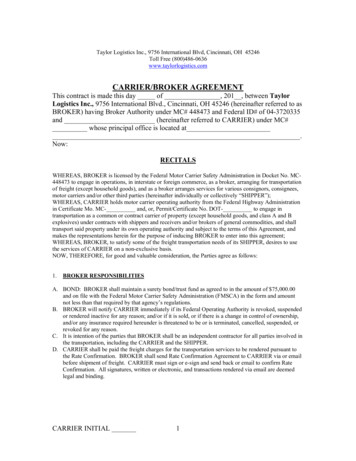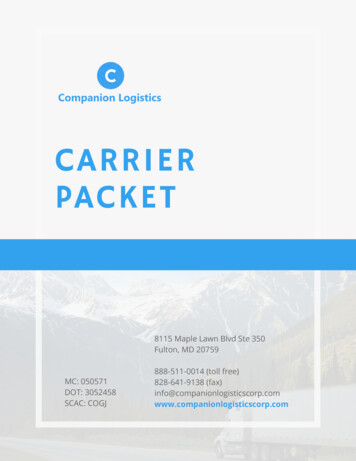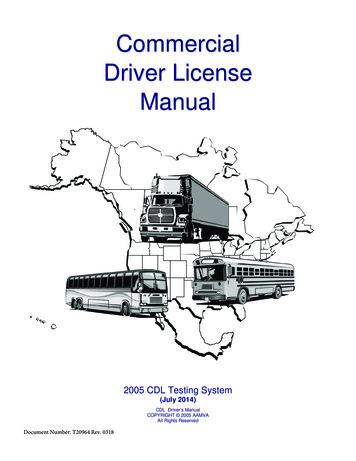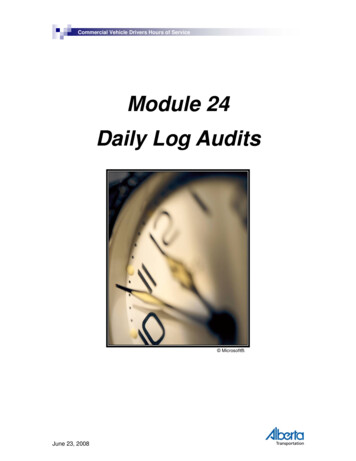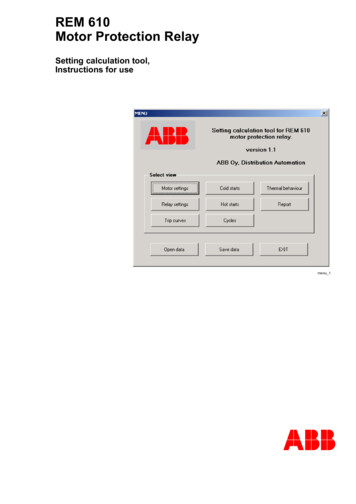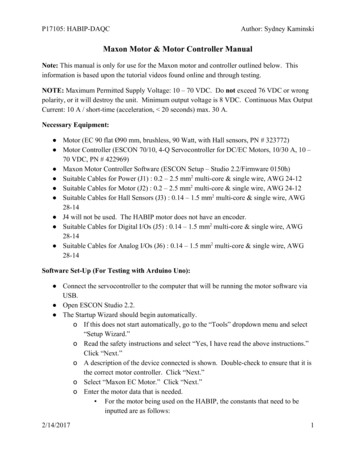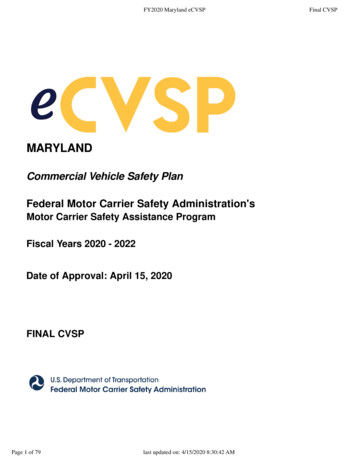
Transcription
FY2020 Maryland eCVSPMARYLANDCommercial Vehicle Safety PlanFederal Motor Carrier Safety Administration'sMotor Carrier Safety Assistance ProgramFiscal Years 2020 - 2022Date of Approval: April 15, 2020FINAL CVSPPage 1 of 79last updated on: 4/15/2020 8:30:42 AMFinal CVSP
FY2020 Maryland eCVSPFinal CVSPPart 1 - MCSAP OverviewPart 1 Section 1 - IntroductionThe Motor Carrier Safety Assistance Program (MCSAP) is a Federal grant program that provides financial assistanceto States to help reduce the number and severity of accidents and hazardous materials incidents involving commercialmotor vehicles (CMV). The goal of the MCSAP is to reduce CMV-involved accidents, fatalities, and injuries throughconsistent, uniform, and effective CMV safety programs.A State lead MCSAP agency, as designated by its Governor, is eligible to apply for grant funding by submitting acommercial vehicle safety plan (CVSP), in accordance with the provisions of 49 CFR 350.201 and 205. The leadagency must submit the State's CVSP to the FMCSA Division Administrator on or before August 1 of each year. For aState to receive funding, the CVSP needs to be complete and include all required documents. Currently, the Statemust submit a performance-based plan each year to receive MCSAP funds.The FAST Act required the Federal Motor Carrier Safety Administration (FMCSA) to “prescribe procedures for a Stateto submit a multiple-year plan and annual updates thereto, under which the State agrees to assume responsibility forimproving motor carrier safety by adopting and enforcing State regulations, standards, and orders that are compatiblewith the regulations, standards, and orders of the Federal Government on commercial motor vehicle safety andhazardous materials transportation safety.”The online CVSP tool (eCVSP) outlines the State’s CMV safety objectives, strategies, activities and performancemeasures and is organized into the following five parts:Part 1: MCSAP OverviewPart 2: Crash Reduction and National Program Elements (FY 2020 - 2022)Part 3: National Emphasis Areas and State Specific Objectives (FY 2020 - 2022)Part 4: Financial Information (FY 2020)Part 5: Certifications and DocumentsYou will find that each of the five eCVSP parts listed above contains different subsections. Each subsection categorywill provide you with detailed explanation and instruction on what to do for completing the necessary tables andnarratives.The MCSAP program includes the eCVSP tool to assist States in developing and monitoring their grant applications.The eCVSP provides ease of use and promotes a uniform, consistent process for all States to complete and submittheir plans. States and territories will use the eCVSP to complete the CVSP and to submit a 3-year plan or an AnnualUpdate to a 3-year plan. As used within the eCVSP, the term ‘State’ means all the States, the District of Columbia, theCommonwealth of Puerto Rico, the Commonwealth of the Northern Mariana Islands, American Samoa, Guam, and theVirgin Islands.REMINDERS FOR FY 2020:Multi-Year plans–For FY 2020, all States will be utilizing the multi-year CVSP format. This means that objectives,projected goals, and activities in the plan will cover a full three-year period. The financial information and certificationswill be updated each fiscal year.Annual Updates for Multi-Year plans–Those States in Year 2 or Year 3 of a multi-year plan will be providing anAnnual Update only. States will be able to review the project plan submitted in the previous year and indicate whetheranything needs to be updated for the upcoming fiscal year via a Yes/No question provided in each Section of Parts1-3. NOTE: Answer carefully as there is one opportunity to check Yes/No and then the input is locked.If Yes is indicated, the information provided for previously will be editable and State users can make anynecessary changes to their project plan. (Note: Trend information that supports your current activities is noteditable.)If No is indicated, then no information in this section will be editable and the user can move forward to the nextsection.The financial information and certifications will be updated each fiscal year.All multi-year and annual update plans have been pre-populated with data and information from their FY 2019 plans.States must carefully review and update this information to reflect FY 2020 activities prior to submission to FMCSA.Page 2 of 79last updated on: 4/15/2020 8:30:42 AM
FY2020 Maryland eCVSPFinal CVSPStates are reminded to not include any personally identifiable information (PII) in the CVSP. The final CVSP approvedby FMCSA is required to be posted to a public FMCSA website.Personally Identifiable Information – PII is information which, on its own or matched with other data, would permitidentification of that individual. Examples of PII include: name, home address, social security number, driver’s licensenumber or State-issued identification number, date and/or place of birth, mother’s maiden name, financial, medical, oreducational records, non-work telephone numbers, criminal or employment history, etc. PII, if disclosed to or alteredby unauthorized individuals, could adversely affect the Agency’s mission, personnel, or assets or expose an individualwhose information is released to harm, such as identity theft.Page 3 of 79last updated on: 4/15/2020 8:30:42 AM
FY2020 Maryland eCVSPFinal CVSPPart 1 Section 2 - Mission/Goal StatementInstructions:Briefly describe the mission or goal of the lead State commercial motor vehicle safety agency responsible foradministering this Commercial Vehicle Safety Plan (CVSP) throughout the State.NOTE: Please do not include information on any other FMCSA grant activities or expenses in the CVSP.The mission of the Maryland State Highway/Motor Carrier Division (SHA/MCD) is to reduce crashes, fatalities and injuries involving trucks and motor coaches while ensuringefficient and effective transportation of passengers, goods, and services for the benefit of all. It is accomplished by providing a framework that fosters inter-agency cooperation, publicprivate partnerships, enhanced regulatory activities, and use of emerging technology. Our lead agency (SHA), along with four State enforcement agencies and twenty-five localenforcement agencies, support the overall mission through daily contact with commercial vehicle drivers and motor carrier representatives during traffic enforcement stops, roadsidesafety inspections, terminal inspections, educational contacts and CSA interventions.Guiding Principles:1. We will continuously improve safety, striving to reduce crashes while improving government and industry productivity to achieve acceleration of economic growth in Maryland.2. We will support the enhancement of safe inter-modal transportation systems.3. We will obtain sustainable funding for the Maryland Motor Carrier Program.4. We will develop and use performance measures to evaluate motor carrier operations and monitor progress toward meeting the program objectives.5. We will regulate motor carriers in a coordinated, efficient, cost-effective, safety-enhancing, and consistent manner.6. We will work for enactment of legislation and regulations that will be consistent with the FMCSR and HAZMAT regulations and enhance CMV safety.7. We will constantly improve communications that will result in educated and informed audiences who actively participate in the Motor Carrier Program.8. We will effectively use appropriate technology and associated procedures to support a safer, more effective and efficient Motor Carrier ProgramPage 4 of 79last updated on: 4/15/2020 8:30:42 AM
FY2020 Maryland eCVSPFinal CVSPPart 1 Section 3 - MCSAP Structure ExplanationInstructions:Briefly describe the State’s commercial motor vehicle (CMV) enforcement program funded by the MCSAP grant.NOTE: Please do not include activities or expenses associated with any other FMCSA grant program.The Maryland MCSAP is comprised of the Motor Carrier Division (MCD) of the Maryland State Highway Administration (SHA), four State enforcement agencies and twenty-fivelocal enforcement agencies. The MCD has been designated as the lead agency to coordinate the efforts of data analysis, enforcement, and industry and safety groups. The MCD isresponsible for writing, managing and monitoring numerous federal grants and for the management of the MCSAP. Additional duties include compiling the annual Size and WeightEnforcement Plan/Certification, the annual Commercial Vehicle Safety Plan (CVSP), and the CMV emphasis area of the Maryland Strategic Highway Safety Plan. The MCD isresponsible for uploading all CMV crashes to SAFETYNET. There are seven positions in the Motor Carrier Division with various MCSAP responsibilities. The CommercialVehicle Enforcement Division (CVED) of the Maryland State Police (MSP) is the lead enforcement agency for commercial vehicle safety in Maryland with a current (as of July, 2019)force of 150 MCSAP certified inspectors (sworn & civilian) and cadets. Additional troopers (45 total), many past members of CVED, assigned to barracks across the state maintaintheir MCSAP certification and conduct safety inspections as part of their daily patrol duties, giving the MSP an overall count of 195 MCSAP certified inspectors (an increase of 8inspectors over last year). Within CVED, sworn police officers and civilian inspectors at 10 fixed Truck Weigh and Inspections Stations (TWIS) and on roving patrols throughoutthe State monitor vehicle safety by performing inspections, enforcing fuel tax regulations, conducting post-crash investigations and giving numerous safety presentations throughoutthe state.As of July, 2019, six personnel within the CVED "ACES" Unit are cross-trained to perform “Compliance Safety & Accountability (CSA)” investigations, Preventive MaintenanceAudits and New Entrant Safety Audits on a full-time basis. A supervisor oversees the unit and is responsible for monitoring the completion of CSA investigations and NewEntrant audits. While the supervisor is certified to conduct safety inspections, the supervisor is not currently certified to conduct investiations or New Entrant Audits. Threeadditional CVED inspectors are trained to conduct CSA investigations on a part-time basis. Six additional inspectors are trained to conduct New Entrant audits on a part-time basis(5 CVED, 1 MDE). An additional three inspectors are currently in the training process and will be available to conduct CSA investigations and New Entrant Safety audits in theFFY2020. Personnel performing New Entrant Safety Audits were funded through a combination of State funds and the MCSAP Basic grant. Maryland provides approximately 80% ofthe costs for Maryland inspectors to perform the New Entry Safety Audits conducted each year. Through the first three quarters of FFY19, Maryland has conducted over 530 NewEntrant audits (source: 24-1 program/ACES Unit). The in-terminal procedures allow our inspectors the opportunity to review documents and vehicles that they will never see atroadside.The CVED uploads all inspection data to SAFETYNET, an automated management information system maintained by the FMCSA. They are also responsible for enforcement ofMaryland’s Diesel Emissions and Noise Abatement Programs. In addition to the re-certification of current inspection personnel, training was provided in the following courses forpersonnel in CVED and all other allied agencies: North American Inspectors Course Parts A and B, Motor Coach Course, General Hazardous Materials, Cargo Tank InspectorsCourses, Radioactive Inspections and Electronic Logging Device course. CVED training unit personnel and MCD personnel also taught as Associate Staff Instructors for FMCSA'sNational Training Center in various locations in other states and U.S. territories.The Commercial Vehicle Safety Unit (CVSU) of the Maryland Transportation Authority Police (MDTAP) has 72 certified inspectors (as of July, 2019) conducting all the enforcementat the TWIS located on Maryland toll facility highways. The TWIS on I-95 at Perryville is the largest in the State with the greatest potential throughput of commercial vehicles.They also have roving units to provide traffic enforcement and inspections away from the stations. The CVSU also provides enforcement at the Maryland Port of Baltimore (POB) andthe BWI Thurgood Marshall Airport. The Maryland Department of Energy (MDE)’s Hazardous Materials Compliance Section (HMCS) has six certified inspectors (as of July, 2019)and is responsible for the safe transportation of hazardous materials. This is accomplished by enforcement of the regulations through inspections and investigations at roadside andin-terminal. Personnel from HMCS have expertise and technical resources regarding hazardous materials that far exceed that of other programs. They have one inspector that is trainedto perform New Entrant Safety Audits. The Public Service Commission (PSC), with five certified inspectors (1 less than last year), performed over 64% of the approximately 1,956motor coach and bus inspections conducted in CY2018. Most of these inspections were performed as Level V inspections. In CY2018, of the 115,890 inspections completed, 67%were conducted by the CVED, 24% by the CVSU, and 9% by the other participants (inspection data was obtained from the CVED database for the calendar year 2018). Enforcementpersonnel from local cities or counties make up the balance of our program, performing traffic enforcement and inspections on roads not patrolled by larger agencies. As of July, 2019there are 25 local agencies (133 inspectors) that participate in the MCSAP program (this is an increase over last year). We remain active in our efforts to recruit new agenciesthroughout the state. Overall, Maryland has 412 certified inspectors working within state and local enforcement agencies across the state.There are 13 fixed inspection sites in Maryland – 10 of which are operated by the CVED of the MSP, and three of which are operated by the CVSU of the MDTAP. These fixed sitesare strategically located to provide the maximum coverage on interstate and U.S. truck routes. Unfortunately, several of our fixed facilities have been periodically closed for weeks oreven months for renovations/repairs due to their age. Our Conowingo station in Harford County remains closed for the upcoming year and is not expected to re-open until mid-2021as a new scale house is constructed. While the facilities are closed, personnel work as temporary roving units along with the permanent roving units that are deployed out of theTWIS to intercept potential non-compliant trucks attempting to bypass stations on alternate routes. These roving teams also perform traffic enforcement. The roving units will stoptrucks and perform inspections on safe shoulders or lots or on one of Maryland's ten mobile paved, pull-off locations throughout the state.Maryland now has 19 virtual weigh stations (VWS) operational throughout the state. The virtual weigh stations are located at various locations on US-50, US-301, MD-213,I-95, I-83, US-40, I-895, I-81 and I-695. Our VWS at MD 32 has been decommissioned while the highway is being widened and reconstructed. At this time it is unknown if a newVWS will be built in the area. Ten of the stations are located near Maryland’s toll highways and tunnels. These virtual sites have provided numerous pictures and reports used toidentify potentially unsafe trucks in order to enhance highway safety. The Commercial Vehicle Enforcement Division (CVED) uses the images from these sites to plan enforcementactions and catch overweight CMVs such as dump trucks and tankers from taking rural bypass routes around our weigh stations and traveling overloaded across the Bay Bridge.Altogether, this web of facilities and agency partnerships has made Maryland a national leader in the number of inspections annually performed and number one in inspectionsperformed per lane mile. On July 31, 2014, the American Transportation Research Institute (ATRI) released the results of a study titled, "Evaluating the Impact of Commercial MotorVehicle Enforcement Disparities on Carrier Safety Performance." Within the study, ATRI developed a weighted formula to identify the "Top 10" high-performance states with theintent to allow "both industry and the enforcement community to benefit from the Best Practices of those leading states." Based on their methodology, Maryland placed 1st overallwith a total of 73 points awarded, nearly double the points awarded to the 2nd ranking state. During September of 2015, Maryland was also awarded a "Comprehensive InvestigationsAward" by FMCSA for "the highest achieving comprehensive investigations program in fiscal year 2014."Maryland’s Participating Agencies:State AgenciesMaryland State PoliceMaryland Transportation Authority PoliceMaryland Department of EnvironmentMaryland Public Service CommissionMaryland Department of Transportation (MCD)Page 5 of 79last updated on: 4/15/2020 8:30:42 AM
FY2020 Maryland eCVSPLocal County/City AgenciesAberdeen Police DepartmentAnne Arundel County Police DepartmentBaltimore County Police DepartmentBowie City Police DepartmentCalvert County Sheriff’s OfficeCaroline County Sheriff's OfficeCarroll County Sheriff's OfficeCentreville Police DepartmentCharles County Sheriff’s OfficeFrederick County Sheriff’s OfficeGreenbelt City Police DepartmentHarford County Sheriff's OfficeHoward County Police DepartmentHyattsville Police DepartmentKent County Sheriff’s OfficeLaPlata Police DepartmentMontgomery County Police DepartmentOcean City Police DepartmentPrince George's County Police DepartmentQueen Anne’s County Sheriff’s OfficeRockville Police DepartmentSeat Pleasant Police DepartmentSt. Mary’s County Sheriff’s OfficeTalbot County Sheriff’s OfficeWashington County Sheriff’s OfficePage 6 of 79last updated on: 4/15/2020 8:30:42 AMFinal CVSP
FY2020 Maryland eCVSPFinal CVSPPart 1 Section 4 - MCSAP StructureInstructions:Complete the following tables for the MCSAP lead agency, each subrecipient and non-funded agency conductingeligible CMV safety activities.The tables below show the total number of personnel participating in MCSAP activities, including full time and parttime personnel. This is the total number of non-duplicated individuals involved in all MCSAP activities within the CVSP.(The agency and subrecipient names entered in these tables will be used in the National Program Elements—Roadside Inspections area.)The national program elements sub-categories represent the number of personnel involved in that specific area ofenforcement. FMCSA recognizes that some staff may be involved in more than one area of activity.Lead Agency InformationAgency Name:MD STATE HIGHWAY ADMIN.Enter total number of personnel participating in MCSAP activities7National Program ElementsEnter # personnel belowDriver and Vehicle Inspections2Traffic Enforcement Activities0Investigations*0Public Education and Awareness3Data Collection and Reporting7* Formerly Compliance Reviews and Includes New Entrant Safety AuditsSubrecipient InformationAgency Name:MARYLAND DEPARTMENT OF ENVIRONMENTEnter total number of personnel participating in MCSAP activitiesNational Program Elements6Enter # personnel belowDriver and Vehicle Inspections6Traffic Enforcement Activities0Investigations*1Public Education and Awareness6Data Collection and Reporting2* Formerly Compliance Reviews and Includes New Entrant Safety AuditsPage 7 of 79last updated on: 4/15/2020 8:30:42 AM
FY2020 Maryland eCVSPFinal CVSPSubrecipient InformationAgency Name:MARYLAND STATE POLICEEnter total number of personnel participating in MCSAP activitiesNational Program Elements220Enter # personnel belowDriver and Vehicle Inspections195Traffic Enforcement Activities170Investigations*15Public Education and Awareness150Data Collection and Reporting30* Formerly Compliance Reviews and Includes New Entrant Safety AuditsNon-funded Agency InformationTotal number of agencies:27Total # of MCSAP Participating Personnel:Page 8 of 79209last updated on: 4/15/2020 8:30:42 AM
FY2020 Maryland eCVSPFinal CVSPPart 2 - Crash Reduction and National Program ElementsPart 2 Section 1 - OverviewPart 2 allows the State to provide past performance trend analysis and specific goals for FY 2020 - 2022 in the areasof crash reduction, roadside inspections, traffic enforcement, audits and investigations, safety technology and dataquality, and public education and outreach.Note: For CVSP planning purposes, the State can access detailed counts of its core MCSAP performance measures.Such measures include roadside inspections, traffic enforcement activity, investigation/review activity, and data qualityby quarter for the current and past two fiscal years using the Activity Dashboard and/or the CVSP Toolkit on the A&IOnline website. The Activity Dashboard is also a resource designed to assist the State with preparing their MCSAPrelated quarterly reports and is located at: http://ai.fmcsa.dot.gov. A user id and password are required to access thissystem.In addition, States can utilize other data sources available on the A&I Online website as well as internal State datasources. It is important to reference the data source used in developing problem statements, baselines andperformance goals/ objectives.Page 9 of 79last updated on: 4/15/2020 8:30:42 AM
FY2020 Maryland eCVSPFinal CVSPPart 2 Section 2 - CMV Crash ReductionThe primary mission of the Federal Motor Carrier Safety Administration (FMCSA) is to reduce crashes, injuries andfatalities involving large trucks and buses. MCSAP partners also share the goal of reducing commercial motor vehicle(CMV) related crashes.Trend Analysis for 2014 - 2018Instructions for all tables in this section:Complete the tables below to document the State’s past performance trend analysis over the past five measurementperiods. All columns in the table must be completed.Insert the beginning and ending dates of the five most recent State measurement periods used in theMeasurement Period column. The measurement period can be calendar year, Federal fiscal year, State fiscalyear, or any consistent 12-month period for available data.In the Fatalities column, enter the total number of fatalities resulting from crashes involving CMVs in the Stateduring each measurement period.The Goal and Outcome columns allow the State to show its CVSP goal and the actual outcome for eachmeasurement period. The goal and outcome must be expressed in the same format and measurement type(e.g., number, percentage, etc.).In the Goal column, enter the goal from the corresponding CVSP for the measurement period.In the Outcome column, enter the actual outcome for the measurement period based upon the goal thatwas set.Include the data source and capture date in the narrative box provided below the tables.If challenges were experienced while working toward the goals, provide a brief narrative including details of howthe State adjusted the program and if the modifications were successful.ALL CMV CRASHESSelect the State’s method of measuring the crash reduction goal as expressed in the corresponding CVSP by usingthe drop-down box options: (e.g. large truck fatal crashes per 100M VMT, actual number of fatal crashes, actualnumber of fatalities, or other). Other can include injury only or property damage crashes.Goal measurement as defined by your State: Actual # FatalitiesIf you select 'Other' as the goal measurement, explain the measurement used in the text box provided:MeasurementPeriod (Include 5 Periods)Page 10 of 79FatalitiesGoalOutcomeBegin DateEnd 1566646601/01/201412/31/2014516651last updated on: 4/15/2020 8:30:42 AM
FY2020 Maryland eCVSPFinal CVSPMOTORCOACH/PASSENGER CARRIER CRASHESSelect the State’s method of measuring the crash reduction goal as expressed in the corresponding CVSP by usingthe drop-down box options: (e.g. large truck fatal crashes per 100M VMT, actual number of fatal crashes, actualnumber of fatalities, other, or N/A).Goal measurement as defined by your State: Actual # FatalitiesIf you select 'Other' or 'N/A' as the goal measurement, explain the measurement used in the text boxprovided:MeasurementPeriod (Include 5 Periods)Page 11 of 79FatalitiesGoalOutcomeBegin DateEnd 1/201412/31/2014000last updated on: 4/15/2020 8:30:42 AM
FY2020 Maryland eCVSPFinal CVSPHazardous Materials (HM) CRASH INVOLVING HM RELEASE/SPILLHazardous material is anything that is listed in the hazardous materials table or that meets the definition of any of thehazard classes as specified by Federal law. The Secretary of Transportation has determined that hazardous materialsare those materials capable of posing an unreasonable risk to health, safety, and property when transported incommerce. The term hazardous material includes hazardous substances, hazardous wastes, marine pollutants,elevated temperature materials, and all other materials listed in the hazardous materials table.For the purposes of the table below, HM crashes involve a release/spill of HM that is part of the manifested load. (Thisdoes not include fuel spilled from ruptured CMV fuel tanks as a result of the crash).Select the State’s method of measuring the crash reduction goal as expressed in the corresponding CVSP by usingthe drop-down box options: (e.g., large truck fatal crashes per 100M VMT, actual number of fatal crashes, actualnumber of fatalities, other, or N/A).Goal measurement as defined by your State: Actual # FatalitiesIf you select 'Other' or 'N/A' as the goal measurement, explain the measurement used in the text boxprovided:MeasurementPeriod (Include 5 Periods)Page 12 of 79FatalitiesGoalOutcomeBegin DateEnd 1/201412/31/2014000last updated on: 4/15/2020 8:30:42 AM
FY2020 Maryland eCVSPFinal CVSPEnter the data sources and capture dates of the data listed in each of the tables above.Crash data for years 2014 - 2018 extracted from the Maryland Automated Crash Reporting System (ACRS) databasedated July 2, 2019.Narrative: Describe any difficulties achieving the goal, problems encountered, obstacles overcome, lessonslearned, etc.Trend Analysis: CY2014 - CY2018In the past, when we had established our three-year objec ve in the FFY2014 CVSP for the period of 1/1/13 through 12/31/15, wehad changed our goal measurement from fatal crashes per 100M VMT to the actual number of fatali es or lives lost. For this CVSP,we con nue to track the actual number of fatali es instead of fatal crashes per VMT. This trend analysis s ll includes the final twoyears of our past mul -year objec ve that was to reduce the number of fatali es that had occurred in our baseline year CY2012 (70)down to 64 fatali es in CY2015 (the FY2014 CVSP incorrectly had 62 fatali es as the stated goal - actual goal was to reduce fatali esby 6 lives over 3 years which would be down to 64 fatali es).At the first-year mark (the end of CY2013) we had experienced a total of 58 fatali es for the CY2013. Our first-year benchmark wouldhave been to reduce fatali es by two to a total of 68 for CY2013. For CY2014, our goal would have been an overall reduc on of fourfatali es to 66 total fatali es for the CY2014. We were again already below our mul -year goal of only 64 fatali es by the end ofcalendar year 2015 when we experienced 50 fatali es in CY2014, a further reduc on in the previous year’s total. Although we hadmet and actually exceeded our three-year goal by the end of the first and second years, we con nued to work towards our statedmul -year goal of reducing fatali es to 64 for the CY2015. Unfortunately, we experienced 66 fatali es in CY2015. The increase wasnot unexpected due to improving economic condi ons in the state and the an cipated increase in truck traffic on the highways. ForCY2016, we again experienced 66 fatali es across the state while experiencing a slight increase in the actual number of fatalcrashes. For CY2017, we saw a sharp reduc on in fatali es with a total of 52 compared to the previous year's total of 66. DuringCY2018 we experienced an increase in fatali es to 71, exceeding our FY2019 CVSP stated goal of only 58 fatali es.Our high crash areas in the Bal more/Washington Metro area (Bal more, Montgomery and Prince George's Coun es) have been afocus of enforcement efforts in our endeavor to reduce fatal CMV crashes. In CY2018, Bal more County experienced 9 fatal crashes(5 in CY2017), which was above the five-year average of 6 fatal crashes (CY13 – CY17). Prince Georges County experienced 10 fatalcrashes in CY2018, which was a decrease from the 12 fatal crashes experienced in CY2015, but higher than the totals of 8 each yearin CY2016 and CY2017. The number of fatal crashes in CY2018 was also higher than the previous five-year average of 8 fatal crashesper calendar year (CY2013 - CY2017). Montgomery County had a total of 1 fatal crash in CY2018, the same number that hadoccurred in CY2017. This was a reduc on from the 3 fatal crashes in CY2016 and also below the previous five-year average of 2.2fatal crashes (CY2013 - CY2017). The 20 total fatal crashes in the three coun es in CY2018 accounted for 30% of all CMV related fatalcrashes (31% of fatali es) across the state. This was a slight increase over the 27% of the fatal crashes (31% of fatali es) a ributedto those three coun es in CY2017. Even though this was a slight increase over the previous year, as a comparison, in CY2011the three coun es accounted for 41% of all fatali es. In 2012 the three coun es accounted for 37% of all CMV fatal crashes. Eventhough in CY2017 Maryland had experienced an 18% decrease in fatal accidents compared to CY2016 (50 compared to 61) and a21% decrease in fatali e
3. We will obtain sustainable funding for the Maryland Motor Carrier Program. 4. We will develop and use performance measures to evaluate motor carrier operations and monitor progress toward meeting the program objectives. 5. We will regulate motor carriers in a coordinated, efficient, cost-effective, safety-enhancing, and consistent manner. 6.
![DEPARTMENT OF TRANSPORTATION [4910-EX-P] Federal Motor Carrier Safety .](/img/57/unified-carrier-registration-plan-fees.jpg)
